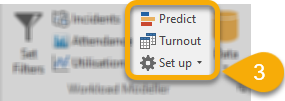About Cadcorp Workload Modeller Add-in
The Cadcorp Workload Modeller Add-in is designed to extend the functionality of SIS Desktop 9.0.
Workload Modeller provides tools for analysing incident-related data stored in an Access or SQL Server database and for modelling scenarios using different resource profiles.
There are three functional areas to Workload Modeller:

- Load ‘raw’ incident data into an Access or SQL Server database (an ‘open’ format) so the data:
- can be viewed in Cadcorp SIS Desktop as view points datasets
- can be manipulated by WebMap (for Analysis and Modelling)
- is available for other analytic functions

- Incident Analysis tools for:
- response (appliance attendance) time to callouts
- allocation of incidents or callouts to stations
- unit utilisation of appliances by time or station

- Modelling tools to:
- predict the use of appliances at locations to meet demand
- simulate the turn-out of appliances to meet demand

Handling Analysis and Modelling Results
The main output of the Analysis tools and the Modelling tools prediction is in the form of Excel workbooks.
The output of a Modelling tools simulation is a new table in the database which can be analysed with the Incident Analysis tools.
Glossary of terms used in this Help
|
Deployment Rules |
These are used in the creation of a Prescribed Response. Deployment Rules are the set of conditions that each incident is compared against to determine the level of response to appear in the resultant ‘Appliance Request Table’. |
|
Dual Staffing |
A system whereby Special Request vehicles are mobilised by using the crew of another appliance; this means the resourcing appliance is unavailable for the duration of the Special Request vehicle’s callout. |
|
Named Periods |
A Named Period is a set of parameters that can be set to define a specific window of time (e.g. ‘Day’, ‘Night’, ‘Summer weekend afternoons’ etc) |
|
Prescribed Response |
This is an ‘Appliance Requests Table’ (which can be used in the ‘Predict’ and ‘Turnout’ modelling commands) where the appliance requests have been generated for a set of historic incidents using Deployment Rules instead of being copies of the historic callouts. |